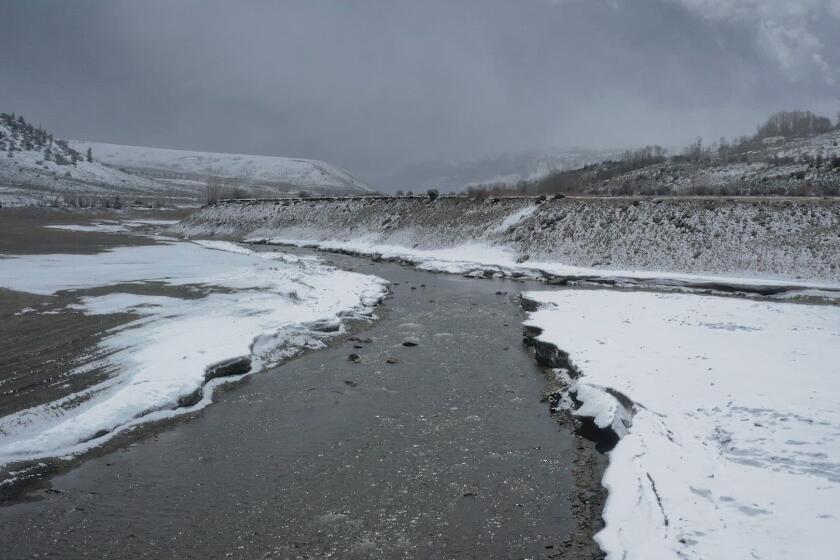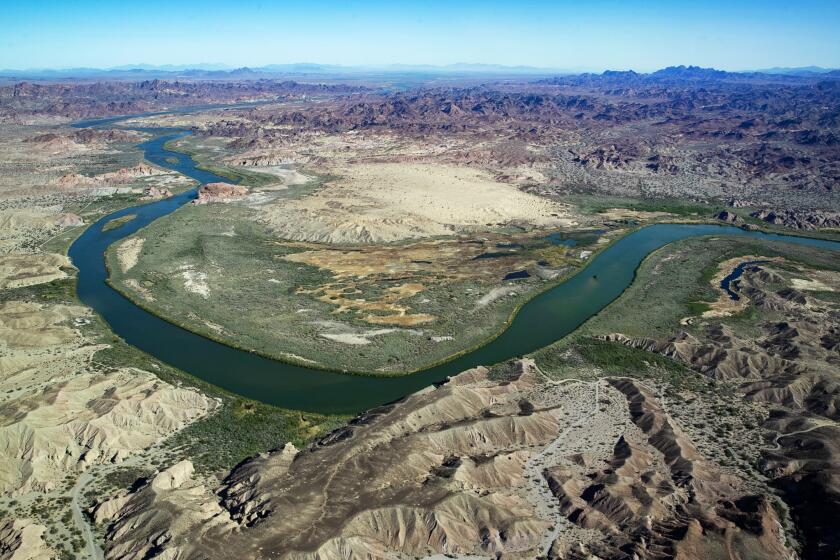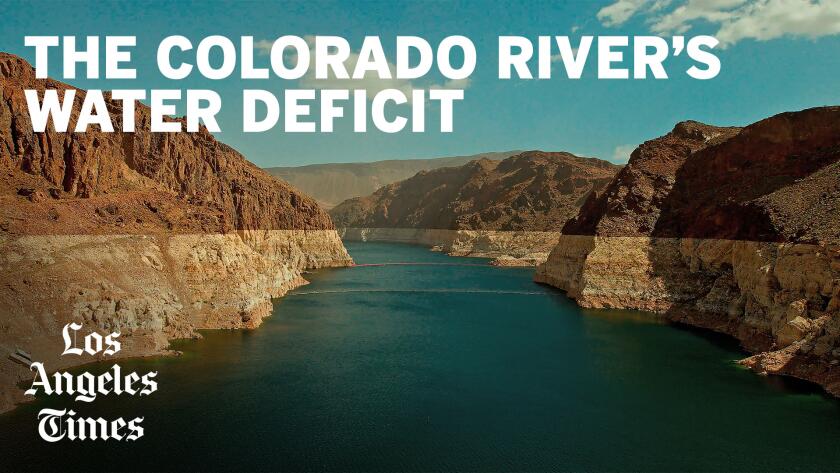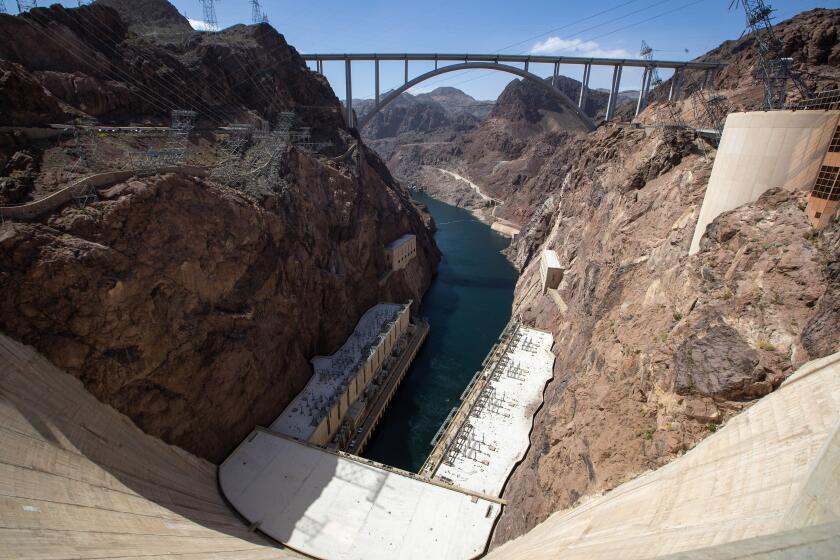Breakthrough Colorado River deal reached, outlining big water cuts for three years
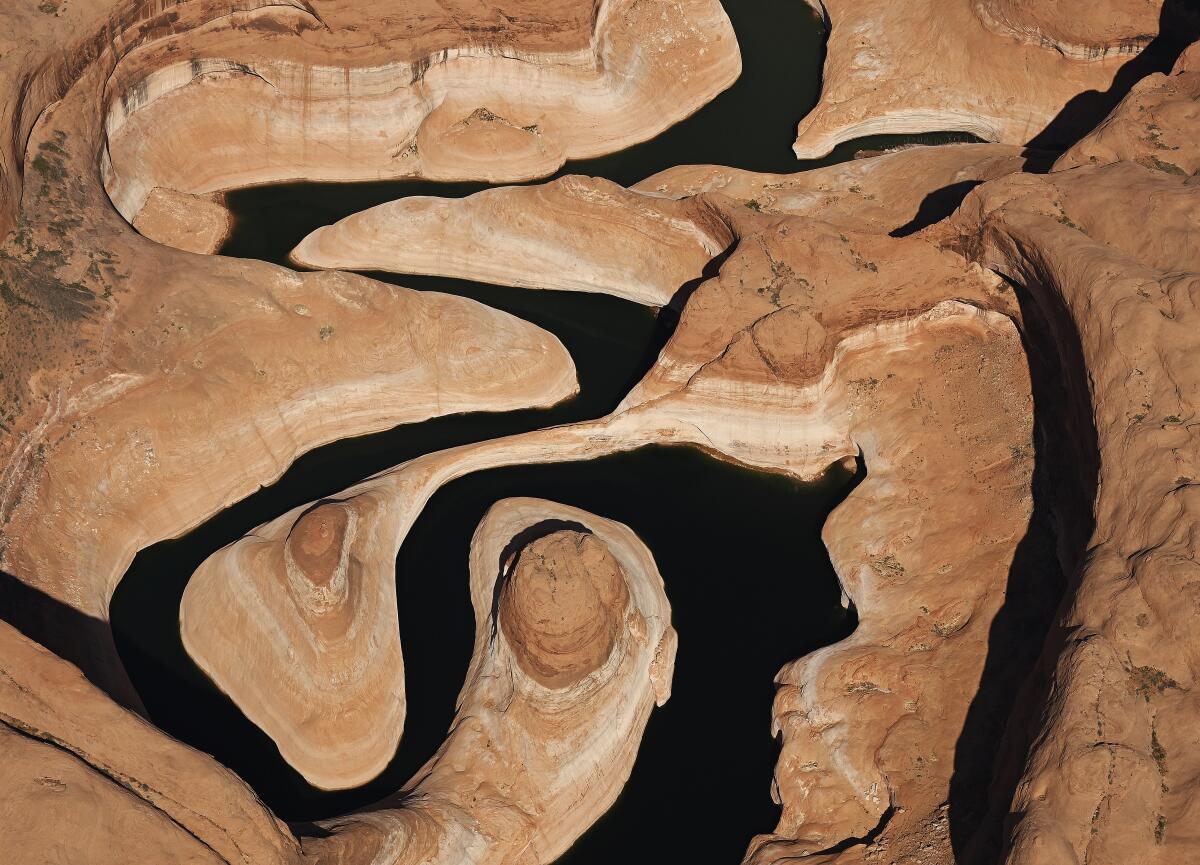
The seven states that depend on the Colorado River announced on Monday that they have reached an agreement on cutting water use from the river over the next three years to prevent reservoirs from falling to critically low levels.
Representatives of the states reached the consensus after months of negotiations, with California, Arizona and Nevada together committing to reduce water use by 3 million acre-feet between now and the end of 2026 — an average of 1 million acre-feet per year, cutting usage by about 14% across the Southwest.
The agreement represents a major milestone in the region’s efforts to grapple with the Colorado River’s decline. The river, which supplies states from the Rocky Mountains to the U.S.-Mexico border, has long been over-allocated, and its reservoirs have declined to their lowest levels on record during 23 years of drought worsened by rising temperatures with climate change.
The Biden administration announced that the federal Interior Department, which had laid out options for larger reductions, will analyze the proposal from the states.
“This is an important step forward towards our shared goal of forging a sustainable path for the basin that millions of people call home,” Bureau of Reclamation Commissioner Camille Calimlim Touton said.
Interior Secretary Deb Haaland called the agreement a testament to the Biden administration’s commitment to working with states, tribes and communities in the West “to find consensus solutions in the face of climate change and sustained drought.”
Colorado River in Crisis is a series of stories, videos and podcasts in which Los Angeles Times journalists travel throughout the river’s watershed, from the headwaters in the Rocky Mountains to the river’s dry delta in Mexico.
The proposed cuts under the agreement amount to about half of the reductions federal officials had called for previously.
The Bureau of Reclamation last month laid out two options for preventing the Colorado River’s depleted reservoirs from reaching dangerously low levels, saying the water cuts could be imposed by following the water-rights priority system or by using an across-the-board percentage. Under those alternatives, federal officials said the cuts would reach about 2 million acre-feet each year — a much larger reduction from the three states’ total apportionment of 7.5 million acre-feet.
The river has received a desperately needed boost this year from storms that left the Rocky Mountains blanketed with heavy snow. Federal officials have estimated that runoff into the river’s reservoirs this year will be 149% of average.
With reservoirs projected to rise substantially this year, the seven states — California, Arizona, Nevada, Utah, Colorado, New Mexico and Wyoming — have come forward with a proposal for smaller reductions that water managers think will be sufficient to prevent reservoirs from reaching perilously low levels for now, even if dry conditions return during the next three years.
The Biden administration had presented its alternatives last month as part of a review aimed at revising the rules for dealing with water shortages through 2026, when the current rules expire. But the Interior Department said that in light of the proposal from the states, it is temporarily withdrawing the draft review “so that it can fully analyze the effects of the proposal.” The Bureau of Reclamation plans to update its review of alternatives, called a draft supplemental environmental impact statement, to include the states’ proposal as an alternative and complete the review this year.
Federal officials said much of the reductions will come by paying agricultural landowners, irrigation districts and other water users to conserve water, using $1.2 billion from the Inflation Reduction Act. Conserved water will remain in Lake Mead, the nation’s largest reservoir, near Las Vegas, which is at 30% of capacity.
The Biden administration has presented options for preventing the Colorado River’s reservoirs from dropping to critically low levels over the next three years.
California, as the state that uses the largest share of the Colorado River, has pledged to shoulder a large share of the reductions — about 1.6 million acre-feet through 2026. An acre-foot is enough water to supply three average households for a year.
The consensus reached among the states will “protect the Colorado River system for the duration of the current guidelines,” said JB Hamby, chair of California’s Colorado River Board.
Hamby said the plan presented by the states will “generate unprecedented volumes of conservation that will build elevation in Lake Mead, make strategic use of the improved hydrology, and build upon partnerships within and between states,” as well as among urban water agencies, agricultural irrigation districts and tribes that depend on the river.
He said the plan would result in “better protection” for the river system than the other options by implementing large cuts sooner, and by reaching half of the total reductions — 1.5 million acre-feet — by the end of 2024.
Many of the details of how federal money will be used to compensate water users have yet to be finalized. So far, federal officials have announced that $233 million will go to Arizona’s Gila River Indian Community, much of it to compensate the tribal nation for leaving water in Lake Mead.
Los Angeles Times reporter Ian James visits Lake Mead, Hoover Dam and farming areas in Southern California on a tour with managers of the Metropolitan Water District. Leaders of water agencies that supply cities and farms are discussing ways of reducing water use to address the river’s crisis.
The Imperial Irrigation District, which delivers the single largest share of Colorado River water to farms in the Imperial Valley, has pledged to contribute 250,000 acre-feet of water per year. Once an agreement on federal funding is completed, growers are expected to be able to volunteer to reduce water use in exchange for payments. The amount has yet to be announced.
The Palo Verde Irrigation District, which supplies farmlands next to the Colorado River around Blythe, plans to scale up a land-fallowing program in which growers are paid to leave some of their fields dry. Starting in August, the amount of farmland out of production in the area is expected to increase from about 20,000 acres to more than 26,000 acres, about 28% of the area’s farmland, with federal money going to farmers and the water staying in Lake Mead.
Managers of the Metropolitan Water District of Southern California, which supplies cities across the region, expect to leave a portion of their allotment in Lake Mead, but these and other details remain to be firmed up and voted on later this year.
The long-depleted Colorado River is getting a boost from the largest snowpack since 1997. Rising reservoirs offer some relief amid talks on needed water cuts.
The governors of California, Arizona and Nevada praised the agreement as an effective strategy for stabilizing the river’s reservoirs through 2026.
Gov. Gavin Newsom said that California has “stepped up to make significant cuts to water usage,” and that the agreement “will help maintain critical water supply for millions of Americans as we work together to ensure the long-term sustainability of the Colorado River.”
President Biden said the agreement on a consensus-based approach “marks an important step forward in our efforts to protect the stability of the Colorado River System in the face of climate change and historic drought conditions.”
The 1922 agreement that originally divided the river among the states promised more water than the Colorado could deliver. And global warming has compounded the strains on the water supply.
In the last 23 years, as rising temperatures have intensified the drought, the river’s flow has declined about 20%.
Scientists have found that roughly half the decline in the river’s flow has been caused by higher temperatures, and that climate change is driving the aridification of the Southwest. With global warming, average temperatures across the upper watershed — where most of the river’s flow originates — have risen about 3 degrees since 1970.
Research has shown that for each additional 1 degree Celsius (1.8 degrees Fahrenheit), the river’s average flow is likely to decrease about 9%.
Scientists have long warned that the river was headed for a crisis. Years before the current shortage, in the 1990s and 2000s, scientists repeatedly alerted public officials that the chronic overuse of the river combined with the effects of climate change would probably drain the reservoirs.
In 2019, as reservoirs were dropping, water managers agreed to reduce water use under a deal called the Drought Contingency Plan. But when those reductions were insufficient, the states agreed to additional cuts in 2021, which projections later showed would not be enough to address risks of Lake Mead declining toward “dead pool” levels, at which water would no longer pass downstream through Hoover Dam.
While the ample snow in the Rockies has reduced those risks for the next couple of years, scientists have continued to advise officials that larger cuts will be necessary.
The plan to cut water usage by an average of 1 million acre-feet each year for three years represents a 14% reduction in consumptive water use in the three Lower Basin states of California, Arizona and Nevada, said Jack Schmidt, a professor and director of Utah State University’s Center for Colorado River Studies.
“It’s a great start,” Schmidt said. “This is one step.”
Schmidt has estimated that based on the decline in the river’s flow this century, the Colorado River Basin will need 4 million acre-feet in reductions annually to address the water deficit and allow for reservoirs to recover.
“It’s about 25% of where we ultimately need to get,” Schmidt said.
“They still have to find another 3 million acre-feet to save,” Schmidt said. “A big, heavy lift still lies ahead.”
Years ago, scientists said climate change would bring a Colorado River crisis. Their warnings, which largely went unheeded, are now playing out.
Last year, federal officials called for cutting water use by 2 million to 4 million acre-feet per year to address the unresolved water shortfall.
When the Biden administration initially presented two options for reductions in April, those alternatives were partly based on conflicting plans that were presented by California and the other six basin states after officials failed to come to an agreement.
Negotiations over the last year have at times grown tense. But in recent weeks, the talks progressed to a point that officials from California, Arizona and Nevada, who had deadlocked on dueling proposals previously, were able to bridge their differences.
Representatives of the seven states laid out the agreement in a letter, saying they “recognize that having one good winter does not solve the systemic challenges facing the Colorado River.” The states’ representatives urged federal officials to advance the process of negotiating new rules for dealing with shortages after 2026, “so that all parties can focus on their resources” on developing a new long-term plan for sharing shortages.
The proposal from the states “protects the system in the short term so we can dedicate our energy and resources to a longer-term solution,” said Brenda Burman, general manager of the Central Arizona Project, which delivers water to Phoenix and Tucson.
The new rules that need to be negotiated by the end of 2026 are to replace the current 2007 guidelines. With that task ahead, Burman said, “there’s a lot to do and it’s time to focus.”
Some environmental activists criticized the short-term deal as being a far cry from what’s needed.
“The feds just want a deal. Is it the right deal? Absolutely not,” said John Weisheit, an activist who co-founded the group Living Rivers. “Where is the climate adaptation deal? There isn’t one.”
The states’ proposal leaves the door open for further negotiated cuts, as well as federally mandated cuts, if Lake Mead is forecast to decline toward critically low levels at some point during the next three years, said Elizabeth Koebele, an associate professor of political science at the University of Nevada, Reno.
Koebele noted that the states’ plan remains a proposal at this stage and requires analysis, public comment and federal approval, all of which will probably involve some changes. She said she thinks it’s positive that the three Lower Basin states reached a consensus. But she said she’s also concerned that the proposal leaves unsettled exactly how they would divide a portion of the cuts — about 700,000 acre-feet — that would not come in exchange for compensation with federal funds.
It’s also unclear what portion of the federal money will pay for temporarily fallowing fields rather than making more permanent conservation upgrades, Koebele said.
“While temporary conservation can help us avert emergency, it won’t solve our long-term water sustainability problems,” she said.
